 |
||
| T-PS Home | Editorial Board | T-PS in IEEE Xplore | Early Access | Manuscript Submission | ||
| June 2019 FEATURE ARTICLES - THESE ARE OPEN ACCESS FOR A LIMITED TIME | ||
We are pleased to announce that the 2017 Impact Factor for T-PS has increased by 20% and now stands at 1.253!A Frequency-Tunable V -Band Radial Relativistic Backward-Wave Oscillatorby Wenjie Feng, Yanhao Feng, Wanchen Yang, Wenquan Che, and Quan Xue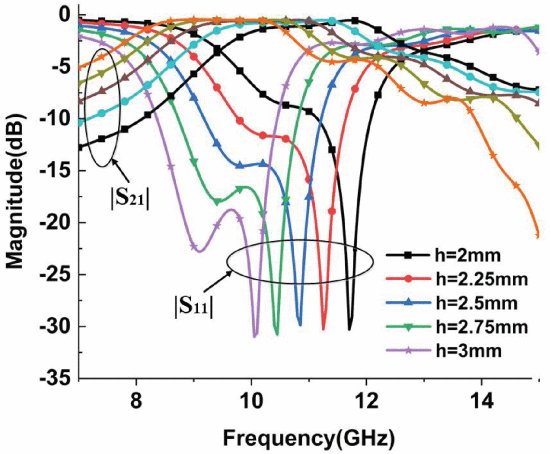 A novel filtering antenna based on periodic spoof surface plasmon polaritons (SSPPs) is proposed. Double-sided parallel-strip line (DSPSL) is used to realize the wideband property for the double-layer SSPPs. Filtering performance can be realized by adding via holes and ring resonators in the double-layer SSPPs. The simulated and measured results indicate the high gain of 9.38 dBi and bandwidth of 10.44% can be achieved for the antenna with via holes and ring resonators, the out-of-band rejection is over 17 dBi. Meanwhile, the gain variations are less than 1 dBi in the whole frequency band. Good agreements can be observed between the measured and simulated results, which indicate good potential applications in the communication systems and integrated circuits. more... | ||
Strongly mismatched regime of nonlinear laser–plasma acceleration: optimization of laser-to-energetic particle efficiencyby Aakash A. Sahai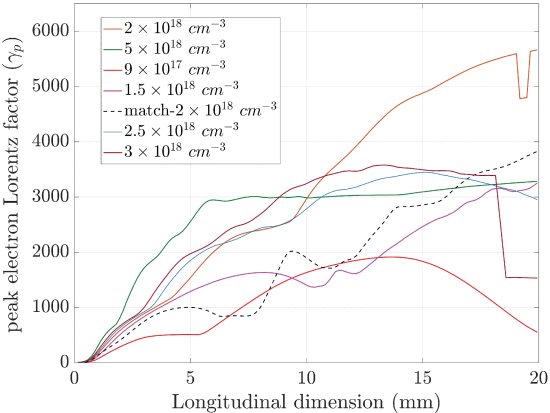 Laser electron accelerators utilize a bubble regime of nonlinear plasma waves driven as laser wakefields that, from theoretical considerations, require a matched laser spot size incident on plasma. A strongly mismatched regime of nonlinear laser–plasma acceleration in the bubble regime, favored by experiments, is introduced and modeled for optimization of laser-to-particle energy efficiency with application to the recently proposed laser positron accelerator. Strong mismatch, in contrast with the matched condition, arises from the incident laser spot size being much larger than that needed for equilibration of the laser ponderomotive and electron-ion charge-separation forces in the nonlinearly driven density structure of a plasma bubble. This is shown to be favorable for optimization of large self-injected electron charge and ultralow transverse emittance without precluding beam spectral shaping. It is shown that there are prominent signatures of the mismatched regime, strong optical-shock excitation, and bubble elongation, which are validated using multidimensional particle-in-cell simulations. This paper thus uncovers a generalized regime that apart from being used in many laser–plasma acceleration experiments also opens a novel pathway for a wide range of future applications. more... | ||
A temporal study of cell death signaling responses to cold atmospheric plasma and electroporation in human cancer cellsby Danielle M. Krug, Prasoon K. Diwakar, and Ahmed Hassanein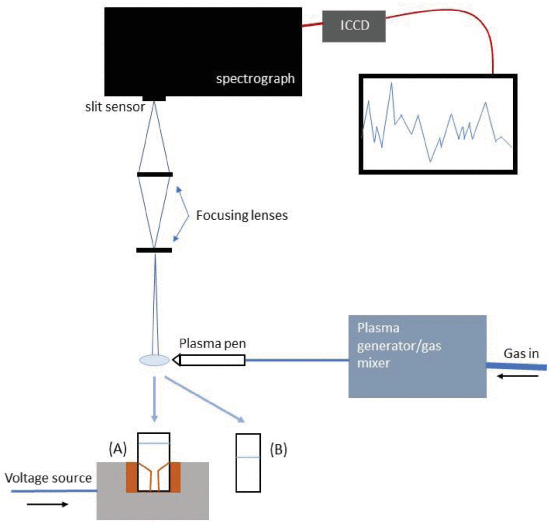 As cancer continues to be one of the world’s leading killers, efforts to replace expensive and invasive therapies that cause harmful side effects led to the exploration of cold atmospheric plasma (CAP) and electroporation (EP) as efficient and selective treatments for the ablation of cancerous tissues. CAP acts by producing reactive oxygen and nitrogen species within irradiated cancer cells, initiating the intrinsic apoptosis pathway through oxidative stress. Another treatment that is also emerging is EP, which compromises plasma membrane stability, resulting in the transmembrane mass transfer or, in extreme electrical field exposure, cell death. The combination of these two methods has not been thoroughly investigated. Although the apoptotic pathway and its components’ responses to cold plasma have been previously explored, there is still a lack of knowledge in the mode of signal propagation and the timeframe in which affected cells begin to feel the plasma’s effects. It has been previously observed that the addition of EP to treatments augments the plasma effects, increasing cancer cell death events. This study tracked apoptotic events through time using flow cytometry and real-time fluorescent microscopy following cold plasma, EP, and a combined plasma/ EP treatment. Flow cytometry analysis of CAP and EP+CAP treated cells suggest that both treatments are effective at killing cancer cells within a short timeframe, with the combined treatment possessing higher killing potential. A 48-h time lapse of treated and untreated live cells reveals that the first 8 h after CAP treatment shows the highest rate of cell death, but the imaging performed on the EP+CAP treatment was largely inconclusive. These treatment methods represent promising emerging technologies in the ongoing battle against cancer but require further investigations. more... | ||
Field-Circuit Coupling Simulation of Petawatt-Class Z-Pinch Acceleratorby Quan Zhou, Xiaobing Zou, and Xinxin Wang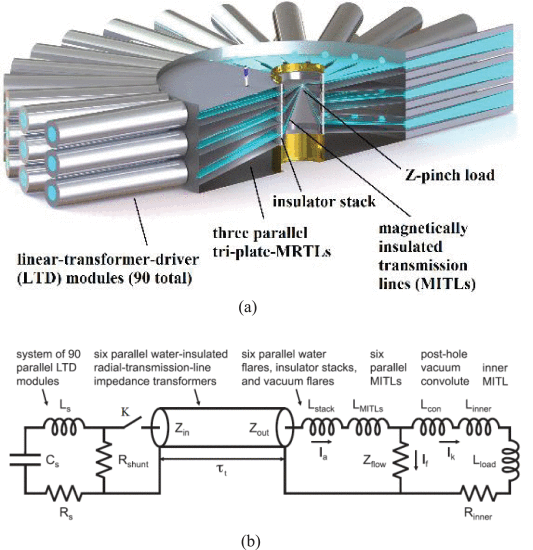 Most of the previous studies of petawatt-class Z-pinch accelerator are performing the circuit simulation based on a full-circuit model. This model may cause nonignorable error because it is under the assumption of TEM modes transmission along the monolithic radial transmission lines (MRTLs). In this paper, a method for field-circuit coupling simulation of petawatt-class Z-pinch accelerator was developed, which considered the non-TEM modes in the MRTLs. A 3-D electromagnetic simulation (EMS) of the MRTLs was conducted, and MRTLs’ equivalent circuit was created based on the scattering transfer parameters drawn from the EMS. By inserting the MRTLs’ equivalent circuit into the pulsed generators and Z-pinch load, a field-circuit coupling model of the whole petawatt-class Z-pinch accelerator was obtained. This method was used in the simulation of Z800 accelerator, a petawatt-class Z-pinch accelerator, and the load was a wire array for Z-pinch. Compared to the previous circuit model, the load current obtained with the field-circuit coupling model was lower, and thus, the load-implosion time was longer. Then, we compared the load current of accelerators using exponential, hyperbolic, and linear MRTLs, respectively, and recommended the linear one. The relation between energy transmission efficiency and load parameters was also investigated. more... | ||
Study on the EM Loads Distribution on Updated HCCB Blanket Inboard and Outboard Blanket Vertical Segmentsby Ming Wang , Mingzhun Lei , Yuntao Song, Mingxuan Lu, Shuling Xu, Kun Lu, Shanwen Zhang, Kun Pei, and Kun Xu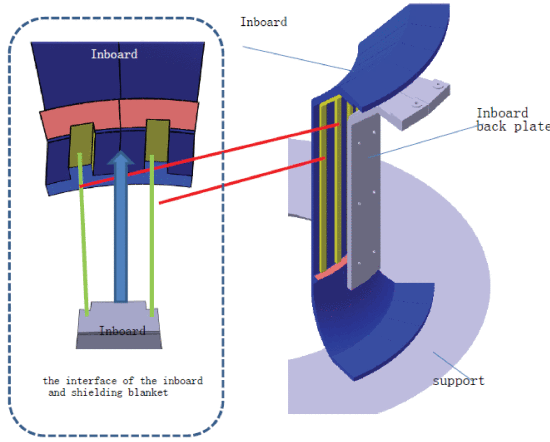 As part of the ongoing China Fusion Engineering Test Reactor (CFETR) studies, this work focused on the study of the electromagnetic (EM) loads distribution on inboard (IB) and outboard (OB) blanket vertical segments. In this paper, a major central disruption scenario with a 36-ms linear current quench was performed in the ANSYS finite element software. EM forces and moments, both on the single module and the complete blanket segment, were calculated for the updated helium-cooled ceramic breeder (HCCB) blanket. Furthermore, the effect of EM loads with respect to poloidal segmentations on the back plate (BP) was studied. Results show that the EM forces and moments in the IB blanket barely changed, but in the OB blanket, great changes occurred. With poloidal segmentations increasing, EM forces loads on the BP will be reduced. This paper may provide important data to support subsequent optimization of the BP of CFETR and could also be a technical reference for other fusion organizations. more... | ||
 |
||
A PUBLICATION OF THE IEEE NUCLEAR AND PLASMA SCIENCES SOCIETY |
||
| June 2019 | VOLUME 47 | NUMBER 6 | ITPSBD | (ISSN 0093-3813) | ||
REGULAR PAPERS |
||
|
Home |
Contact & Support |
Accessibility |
Nondiscrimination Policy |
Feedback |
Privacy and Opting Out of Cookies
© Copyright 2019 IEEE - All rights reserved. Use of this website signifies your agreement to the IEEE Terms and Conditions. A not-for-profit organization, IEEE is the world's largest technical professional organization dedicated to advancing technology for the benefit of humanity. If you have questions about this mailing, or need assistance, please direct your inquiries to the IEEE Contact Center. Replies to this message do not reach IEEE. |
||